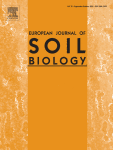Ver ítem
- xmlui.general.dspace_homeCentros Regionales y EEAsCentro Regional Buenos Aires SurEEA BarrowArtículos científicosxmlui.ArtifactBrowser.ItemViewer.trail
- Inicio
- Centros Regionales y EEAs
- Centro Regional Buenos Aires Sur
- EEA Barrow
- Artículos científicos
- Ver ítem
Effect of previous cropping of rapeseed (Brassica napus L.) on soybean (Glycine max) root mycorrhization, nodulation, and plant growth
Resumen
Arbuscular mycorrhizal fungi (AMF) improve the uptake of immobile mineral nutrients such as phosphate, thereby enhancing the growth of most plants. However, plants belonging to the Brassicaceae family such as rapeseed (Brassica napus L.) do not associate with AMF. In Argentina, one of the crops frequently used in rotation with rapeseed is soybean (Glycine max L.). The aim of this study was to evaluate the impact of the non-mycorrhizal rapeseed (inoculated
[ver mas...]
Arbuscular mycorrhizal fungi (AMF) improve the uptake of immobile mineral nutrients such as phosphate, thereby enhancing the growth of most plants. However, plants belonging to the Brassicaceae family such as rapeseed (Brassica napus L.) do not associate with AMF. In Argentina, one of the crops frequently used in rotation with rapeseed is soybean (Glycine max L.). The aim of this study was to evaluate the impact of the non-mycorrhizal rapeseed (inoculated with the phosphorus solubilizing bacteria Bacillus sp. LRCP-4 or Arthrobacter sp. LRCP-11) as the preceding crop, on soybean plants growth, nodulation and AMF colonization. Green house experiments were done using soil samples from rapeseed cultivated fields to growth soybean plants. Results indicated that the soybean interaction with the microsymbiont Bradyrhizobium japonicum E109 was not affected and that the growth of plants in soil previously planted with rapeseed inoculated with Bacillus sp. LRCP-4 was increased (31% and 29% for shoot and root fresh weight respectively). However, it was evident from this study that inclusion of rapeseed in the soybean-based system decrease by a 30% the AMF soybean root colonization.
[Cerrar]

Autor
Valetti, Lucio;
Iriarte, Liliana Beatriz;
Fabra, Adriana;
Fuente
European Journal of Soil Biology 76 : 103-106 (September–October 2016)
Fecha
2016-10
ISSN
1164-5563
Formato
pdf
Tipo de documento
artículo
Palabras Claves
Derechos de acceso
Restringido
 Excepto donde se diga explicitamente, este item se publica bajo la siguiente descripción: Creative Commons Attribution-NonCommercial-ShareAlike 2.5 Unported (CC BY-NC-SA 2.5)
Excepto donde se diga explicitamente, este item se publica bajo la siguiente descripción: Creative Commons Attribution-NonCommercial-ShareAlike 2.5 Unported (CC BY-NC-SA 2.5)

